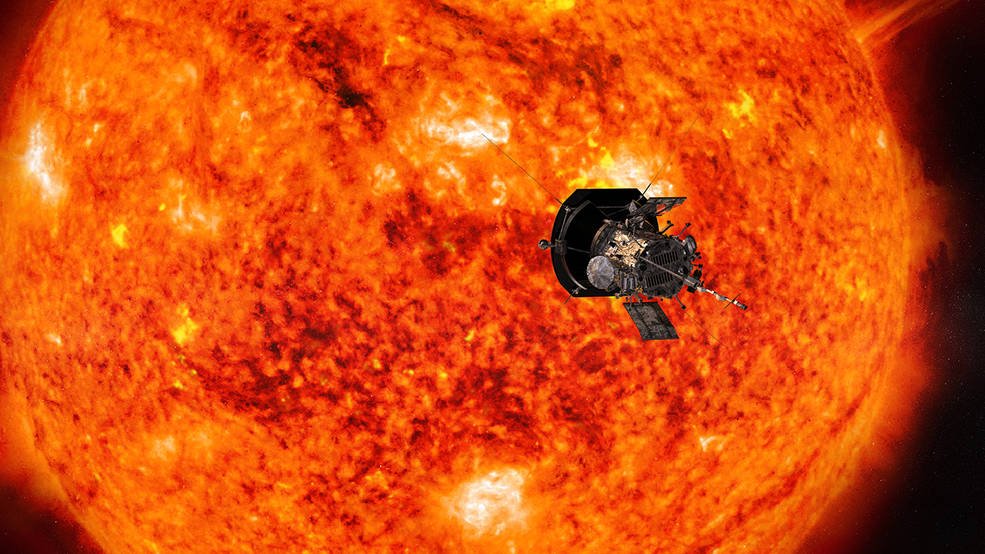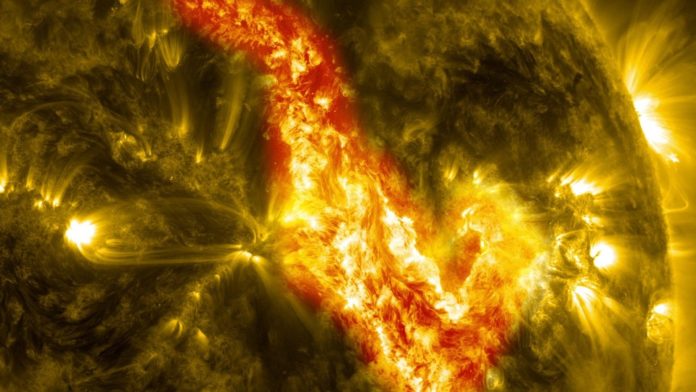The Sun’s corona remained a puzzle even for the scientists who study it closely. It is more than a hundred times hotter than the lower layers, and much closer to the fusion reactor at the Sun’s core. NASA has launched a mission to study the sun’s atmosphere using NASA’s Parker solar probe.
The probe will pass through the corona itself, gather clues to its behavior, and offer the chance for scientists to solve this mystery.
From Earth, the sun’s appearance is quiet, unchanging, visible light. Its surface is turbulent surface is shaken by emissions and exceptional blasts of radiation, which hurl solar material at inconceivable velocities to each side of the close planetary system. This activity causes space weather events that have the potential to disrupt radio communications harm satellites and astronauts.
Before the instruments and spacecraft, the only way to study the sun’s corona was from Earth was during a total eclipse, when the Moon blocks the Sun’s bright face, revealing the surrounding, dimmer corona.
During 1869 total solar eclipse, it was the first time astronomers detected that the coronal heating problem begins with a green spectral line. Since that green line didn’t correspond to any known elements on Earth, scientists thought that they had discovered a new element and named it as coronium.

Credits: NASA’s Goddard Space Flight Center/Gopalswamy
More than a half-century later, a Swedish physicist discovered the element responsible for the emission from the sun. And that element is iron, superheated to the point that it’s ionized 13 times, leaving it with just half the electrons of a normal atom of iron. Scientists calculated that such high levels of ionization would require coronal temperatures around 2 million degrees Fahrenheit — nearly 200 times hotter than the surface.
Justin Kasper, a space scientist at the University of Michigan in Ann Arbor, said, “I think of the coronal heating problem as an umbrella that covers a couple of related confusing problems. First, how does the corona get that hot that quickly? But the second part of the problem is that it doesn’t just start, it keeps going. And not only does heating continue, but different elements are heated at different rates. It’s an intriguing hint at what’s going on with heating in the Sun.”
Physicists are trying hard to understand the behavior of the sun’s corona. They even have come up with powerful models and instruments and launched spacecraft that watch the Sun around the clock. But those models also were able to capture only partially explain coronal heating.
Kasper explained, “We may live within the Sun’s expansive atmosphere, but the corona and solar plasma in near-Earth space differ dramatically. It takes the slow solar wind around four days to travel 93 million miles and reach Earth or the spacecraft that study it — plenty of time for it to intermix with other particles zipping through space and lose its defining features.”
Parker solar probe will travel through the sun’s surface, i.e., the corona and will sample just-heated particles, removing the uncertainties of a 93-million-mile journey and sending back to Earth the most pristine measurements of the corona ever recorded.
Nour Raouafi, Parker Solar Probe deputy project, said, “All of our work over the years has culminated to this point: We realized we can never fully solve the coronal heating problem until we send a probe to make measurements in the corona itself.”
Traveling to the sun is the oldest aim of NASA, but it has taken almost a decade to engineer a technology to make it possible.
One theory proposes electromagnetic waves are the root of the corona’s extreme heat. Perhaps that boiling motion launches magnetic waves of a certain frequency — called Alfvén waves — from deep within the Sun out into the corona, which sends charged particles spinning and heating the atmosphere, a bit like how ocean waves push and accelerate surfers toward the shore.
Another suggests bomb-like explosions, called nanoflares, across the Sun’s surface dump heat into the solar atmosphere. Like their larger counterparts, solar flares nanoflares are thought to result from an explosive process called magnetic reconnection. Turbulent boiling on the Sun twists and contorts magnetic field lines, building up stress and tension until they explosively snap — like breaking an over-wound rubber band — accelerating and heating particles in their wake.
Although these hypotheses are not mutually exclusive, according to scientists both may be involved in heating the corona. They think that the magnetic reconnection that sets off a nanoflare could also launch Alfvén waves, which then further heat the surrounding plasma.
Eric Christian, a space scientist at NASA’s Goddard Space Flight Center in Greenbelt, Maryland, said, “We’re going close to the heating, and there are times Parker Solar Probe will co-rotate, or orbit the Sun at the same speed the Sun itself rotates. That’s an important part of the science. By hovering over the same spot, we’ll see the evolution of heating.”
Goddard solar scientist Nicholeen Viall said, “Parker Solar Probe will swoop within 3.9 million miles of the Sun’s surface — and while this distance may seem great, the spacecraft is well-positioned to detect signatures of coronal heating. Even though magnetic reconnection events take place lower down near the Sun’s surface, the spacecraft will see the plasma right after they occur. We have a chance to stick our thermometer right in the corona and watch the temperature rise. Compare that to studying plasma that was heated four days ago from Earth, where a lot of the 3D structures and time-sensitive information are washed out.”

Credits: NASA/Johns Hopkins APL
Stuart Bale, University of California, Berkeley said, “I’m pretty sure when we get that first round of data back, we’ll see the solar wind at lower altitudes near the Sun is spiky and impulsive. I’d lay my money on the data being much more exciting than what we see near Earth.”
The data is complicated enough — and comes from multiple instruments — that it will take scientists some time to piece together an explanation for coronal heating. And because the Sun’s surface isn’t smooth and varies throughout, Parker Solar Probe needs to make multiple passes over the Sun to tell the whole story. But scientists are confident it has the tools to answer their questions.
Scientists are eager and excited for this mission. Through this, they are expecting to get deep insights into the sun.
Raouafi said, “I’m almost certain we’ll discover new phenomena we don’t know anything about now, and that’s very exciting for us. Parker Solar Probe will make history by helping us understand coronal heating — as well as solar wind acceleration and solar energetic particles — but I think it also has the potential to steer the direction of solar physics’ future.”
